|
|
 |
|
Calanoida ( Order ) |
|
|
|
Arietelloidea ( Superfamily ) |
|
|
|
Heterorhabdidae ( Family ) |
|
|
|
Paraheterorhabdus ( Genus ) |
|
|
|
Paraheterorhabdus ( Sub-Genus ) |
|
|
| |
Paraheterorhabdus (Paraheterorhabdus) medianus (Park, 1970) (F,M) | |
| | | | | | | Syn.: | Heterorhabdus medianus Park, 1970 (p.477, 525, figs.F, no M); Heptner, 1972 a (p.60);
Heterochäta vipera Giesbrecht, 1889; 1892 (p.373, 383, 773, figs.M, non F);
Heterorhabdus vipera : Giesbrecht & Schmeil, 1898 (p.116, Rem. M, no F) | | | | Ref.: | | | Park, 2000 (p.81, figs.F,M, Rem.) | 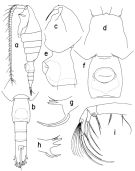 issued from : T. Park in Bull. Scripps Inst. Oceanogr. Univ. California, San Diego, 2000, 31. [p.204, Fig.52]. Female: a, habitus (left side); b, urosome (dorsal); c, d, forehead (left, dorsal, respectively); e, f, genital somite (left, ventral, respectively); g, masticatory edge of left Md (posterior); h, masticatory edge of right Md (posterior); i, left Mx2 (posterior).
|
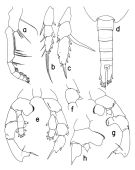 issued from : T. Park in Bull. Scripps Inst. Oceanogr. Univ. California, San Diego, 2000, 31. [p.205, Fig.53]. Female: a, right Mxp (anterior); b, exopod of P1 (anterior); c, exopod of P5 (anterior). Male: d, urosome (dorsal); e, P5 (anterior); f, second exopodal segment of left P5 (anterior); g, right P5 (endopod omitted), posterior; h, basipod of right P5 (anterior).
|
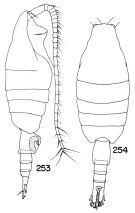 Issued from : T. S. Park in Bull. Mar. Sc., 1970, 20 (2). [p.522, Figs.253-254]. As Heterorhabdus medianus. Female (from Caribbean Sea & G. of Mexico): 253, habitus (lateral right side); 254, idem (dorsal). Nota: Head and 1st thoracic segment separate, 4th and 5th fused. caudal rami asymmetrical.
|
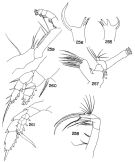 Issued from : T. S. Park in Bull. Mar. Sc., 1970, 20 (2). [p.524, Figs.255-261]. As Heterorhabdus medianus. Female: 255, right Md (biting edge of the mandibular blade); 256, left Md (idem); 257, Mx1; 258, Mx2; 259, Mxp; 260, P1 (anterior); 261, P5 (anterior). Nota: 2nd inner lobe and basis of Mx1, each with 1 seta; endopod with 5 setae. Penultimate lobe of Mx2 elongate and not covered by spinules.
|
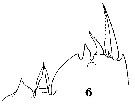 Issued from : W. Giesbrecht in Systematik und Faunistik der Pelagischen Copepoden des Golfes von Neapel und der angrenzenden Meeres-Abschnitte. – Fauna Flora Golf. Neapel, 1892. Atlas von 54 Tafeln. [Taf. 20, Fig.6]. As Heterochäta vipera. Male: 6, exopod 3 of P3.
|
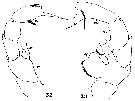 Issued from : W. Giesbrecht in Systematik und Faunistik der Pelagischen Copepoden des Golfes von Neapel und der angrenzenden Meeres-Abschnitte. – Fauna Flora Golf. Neapel, 1892, 19 , Atlas von 54 Tafeln. [Taf.20, Figs.32, 33]. As Heterochäta vipera. Male: 32, left P5 (anterior view); 33, right P5 (anterior view). Nota: Same scale.
|
 Paraheterorhabdus (Paraheterorhabdus) medianus Paraheterorhabdus (Paraheterorhabdus) medianus female: 1 - Left caudal ramus distinctly longer than right and completely fused with anal segment (Fig.52-b) 2 - Dorsally, posterolateral corners of prosome rounded.
|
 Paraheterorhabdus (Paraheterorhabdus) medianus Paraheterorhabdus (Paraheterorhabdus) medianus female: 1 - Left caudal ramus distinctly longer than right and completely fused with anal segment; setation in both rami as in female (Fig.53-d). 2 - Basis of right P5 with wide, rectangular inner lobe. 3 - Exopod of right P5 with wide bilobed distal end (Fig.53-e); 2nd lobe of Mx2 (Fig.52-i) with a long seta.
| | | | | NZ: | 6 | | |
|
Distribution map of Paraheterorhabdus (Paraheterorhabdus) medianus by geographical zones
|
| | | | | | | Loc: | | | off W South Africa, Caribbean Sea, G. of Mexico, off Cape Verde Is., Indian (E equatorial), E Pacif. tropical (N-S), Pacif. tropical (central S-N), Salomon Is.
Type locality: Caribbean Sea and Gulf of Mexico. | | | | N: | 3 | | | | Lg.: | | | (46) M: 2,6; (88) F: 2,6; 2,56; (824) F: 2,88-2,48; M: 2,84-2,6; {F: 2,48-2,88; M: 2,60-2,84} | | | | Rem.: | Mesopelagic.
For Park (1970, p.527) this species shows somewhat intermediate characteristics between P. vipera (Giesbrecht, 1889) and P. robustus (Farran. 1908). | | | Last update : 27/01/2015 | |
|
|
 Any use of this site for a publication will be mentioned with the following reference : Any use of this site for a publication will be mentioned with the following reference :
Razouls C., Desreumaux N., Kouwenberg J. and de Bovée F., 2005-2025. - Biodiversity of Marine Planktonic Copepods (morphology, geographical distribution and biological data). Sorbonne University, CNRS. Available at http://copepodes.obs-banyuls.fr/en [Accessed August 17, 2025] © copyright 2005-2025 Sorbonne University, CNRS
|
|
 |
 |









